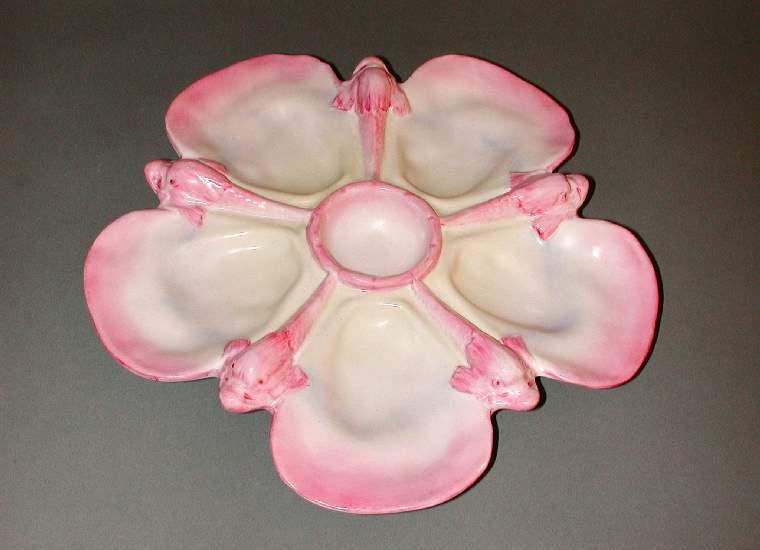Current Location: In storage
Titles
Oyster plate with dolphins
Maker(s)
Factory:
Wedgwood
Entities
Categories
Description
White earthenware, moulded and glazed.
Plate in the form of five oyster shells separated by dolphins, radiating from a small, circular bowl in the centre. On the reverse a low, curved foot supports each shell. The upper surface decorated with pale yellow, pink and purple majolica glazes. The dolphins are covered in shades of pink with eyes and fins picked out in deeper pink. The same pink is used on the outer edges of the shells and around the rim of the central bowl, thicker at the edge and shading away into the depressions, which are tinged with pale yellow. The shape and pearlescence of the inner shells is indicated with a faint application of purple. The reverse clear-glazed.
Notes
History note: Unknown before C.N.P. Powell, by whom given.
Legal notes
Given by C.N. P.Powell, DSO, OBE, FRSL, MA, through the Friends of the Fitzwilliam Museum
Measurements and weight
Diameter: 23.5 cm
Height: 3.7 cm
Acquisition and important dates
Method of acquisition: Given
(1986-04-28)
by
Powell, C. N. Peter
Dating
Victorian
19th Century, Late
Circa
1878
CE
-
1883
CE
Note
The Wedgwood pattern number for these plates is 2754, described as ‘Oyster Tray, Argenta’. They were also produced in other colours, including brown/pink dolphins and a mustard middle on a cream/white plate and cobalt blue shells with grey dolphins and a turquoise middle. Some 42 different entries in the Wedgwood majolica ware pattern books refer to oyster trays and stands, illustrating the range and popularity of oyster plate designs produced.
This is one of a pair of plates held in the Fitzwilliam collection. Oysters were abundant and inexpensive in the 19th Century, and oyster plates were fashionable from mid 1850s until c.1940. Some of the best were made with majolica glazes, introduced by Minton in 1851 and a significant area of Wedgwood production in the 1870s. Both shape and colour are important in majolica ware, and the use of colour to highlight the detail of the moulding on these plates is typical. The delicately applied pink colour and the light purple which mimics the inside of an oyster shell (more evident on this plate than on the other) suggests they were made after 1878, when Wedgwood updated its majolica ware, the new designs favouring embossed, often Japanese-inspired, naturalistic decoration painted in bright majolica colours against a pale or white background. This change, known as Argenta ware, followed the observation that earlier, more deeply coloured majolica seemed to be going out of fashion at the 1878 Paris exhibition. The lozenge-shaped factory mark indicates that the plates were made before 1884.
Components of the work
Reverse
composed of
lead-glaze
( clear)
Front
composed of
opaque glaze
Materials used in production
White earthenware
Techniques used in production
Moulding
: White earthenware, the upper surface decorated with pale yellow, pink and purple glaze.
Lead-glazing
Inscription or legends present
- Text: WEDGWOOD
- Location: On reverse
- Method of creation: Impressed
- Type: Mark
Inscription present: unclear
- Text: possibly 'CUD'
- Location: On reverse
- Method of creation: Impressed
- Type: Mark
- Text: W
- Location: On reverse
- Method of creation: Impressed
- Type: Mark
Inscription present: lozenge shaped Patent Registration mark, possibly incorporating date letter 'D' (1878), but mainly illegible
- Location: On reverse
- Method of creation: Impressed
- Type: Mark
References and bibliographic entries
Identification numbers
Accession number: C.3-1986
Primary reference Number: 12139
Stable URI
Audit data
Created: Saturday 6 August 2011
Updated: Tuesday 30 April 2024
Last processed: Tuesday 13 May 2025
Associated departments & institutions
Owner or interested party:
The Fitzwilliam Museum
Associated department:
Applied Arts




